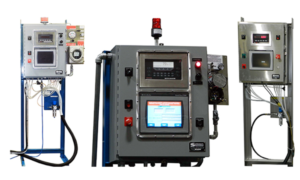A Guide To Upgrading Aging Filler Control Systems
Filling liquid products requires dependable and accurate process automation systems. The vulnerability that comes with using aging controls and the subsequent degrading can lead to production uncertainties and inefficiencies. When it comes to legacy control systems for fillers, some operations managers might work under the assumption that replacing outdated controls with new equipment is always the first answer for increasing efficiency and performance. Sometimes it is and sometimes it isn’t. Often there’s a solution somewhere in the middle—like upgrading and retrofitting—which may be the best way to optimize production, reduce maintenance costs, and increase turnaround time while extending the life cycle of current and future equipment investments.
Proactively Prepare for Upgrading Aging Controls

- Has the support run out on your operating system and HMI software?
- Is your PLC more than 10 years old?
- Are you experiencing an increase in faults or failures?
If you can answer “Yes” to any of these questions, it’s probably time to upgrade your controls. Proactively preparing for the inevitable can minimize your investment and the disruptions to your operations.
Why Upgrade Filling Equipment?
There are several benefits to upgrading your liquid filler control systems, including increased efficiency, reduced risk, and decreased maintenance costs.
Increased efficiency
Filling more products at a faster pace and at a lower cost puts you ahead of the competition. Upgrading controls can be the key to driving new efficiencies as well as reducing errors and improving consistency.
Reduced risk
As controls become obsolete, parts become harder to replace, and technical support is no longer available, a catastrophic and unplanned downtime event could occur. When you upgrade to modern controls, they’re safer, more accurate, and more reliable.
Decreased costs
If you depend on filling machines to keep your products flowing and your business running, outdated control systems can lead to unplanned downtime, which greatly impacts your bottom line. New control systems make your operations more efficient, which can help lower operating and maintenance costs.
When to Upgrade Filling Equipment?
The decision to modernize filler controls is usually driven by one of three reasons:
- Electrical components are obsoleted
- Additional functionality is needed
- Scope of filling operations has changed
Obsoleted
The main reason for upgrading system controls is obsolescence. Electrical components, typically the PLC (Programmable Logic Controllers), HMI (Human Machine Interface) or the displays, become obsolete.
With the arrival of IIoT–or the Industrial Internet of Things–modern devices, software, sensors, and control panels can offer new, real-time visibility into how to improve processes and configurations for filling machines that can help machines perform better. Control panels that are obsolete just can’t do that.
When you upgrade older systems to communicate with IIoT, and use Cloud tools like Drum Filler in the Cloud, you get real-time data from your liquid filling machines that can help you make real-time business decisions based on your actual production.
Additional functionality is needed
Modern technology allows manufacturers to use their equipment to gain more insight into their production values, communicate with other types of management software, and collect more data. This need for increased functionality often means aging controls need to be upgraded.
Scope of operations has changed
As business strategies and/or market demands change, so do business equipment needs. Sometimes this new direction might mean a change in the original equipment to accommodate the shift. This usually requires a combination of new programming and hardware changes. For example, a manufacturer might need to change to a classified system, or change from a non-purge to purged, or add equipment such as labelers, wrappers, or pallet dispensers—all of which require new controls or additional inputs and outputs on controls.
What to Do Before You Upgrade
If your operations can check any of the boxes above, upgrading or retrofitting controls may be on your horizon. Before jumping headfirst into the project, here are some considerations that can help ensure a smooth process.
- When is the best time to take the filler down?
- How long will the filler be down?
- What will operations look like while the machine is down?
- What is the total cost of the upgrade?
Specialty Equipment’s Upgrade Solutions
In addition to designing and manufacturing automatic and semi-automatic fillers, Specialty Equipment also builds all the necessary conveyors, controls, programming, and wiring—all tested in our plant. We can upgrade any of our fillers or retrofit controls on fillers from other manufacturers. Our experienced technicians can help clients troubleshoot and improve or upgrade existing control systems to extend the life of their filling equipment and keep operations running smoothly to avoid costly downtime.
